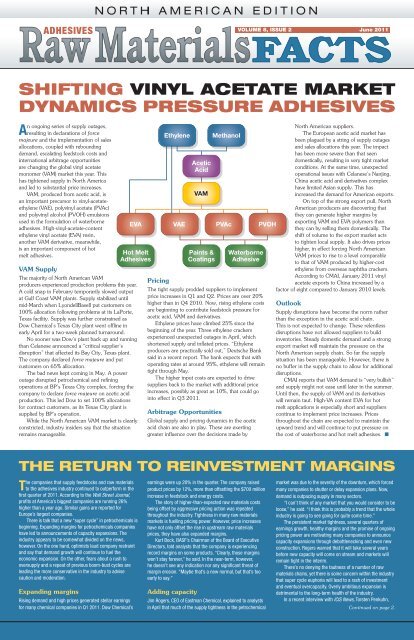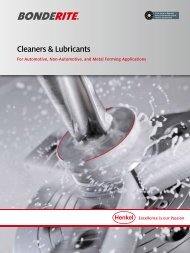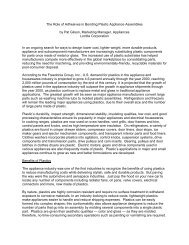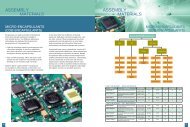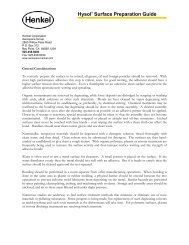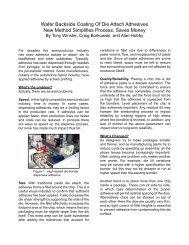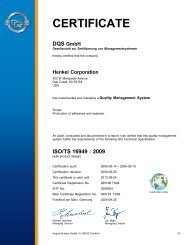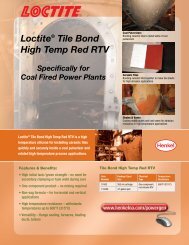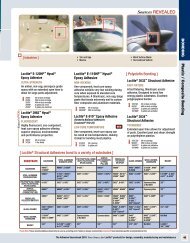Create successful ePaper yourself
Turn your PDF publications into a flip-book with our unique Google optimized e-Paper software.
An ongoing series of supply outages,<br />
resulting in declarations of force<br />
majeure and the implementation of sales<br />
allocations, coupled with rebounding<br />
demand, escalating feedstock costs and<br />
international arbitrage opportunities<br />
are changing the global vinyl acetate<br />
monomer (VAM) market this year. This<br />
has tightened supply in <strong>North</strong> <strong>America</strong><br />
and led to substantial price increases.<br />
VAM, produced from acetic acid, is<br />
an important precursor to vinyl-acetateethylene<br />
(VAE), polyvinyl acetate (PVAc)<br />
and polyvinyl alcohol (PVOH) emulsions<br />
used in the formulation of waterborne<br />
adhesives. High-vinyl-acetate-content<br />
ethylene vinyl acetate (EVA) resin,<br />
another VAM derivative, meanwhile,<br />
is an important component of hot<br />
melt adhesives.<br />
VAM Supply<br />
The majority of <strong>North</strong> <strong>America</strong>n VAM<br />
producers experienced production problems this year.<br />
A cold snap in February temporarily slowed output<br />
at Gulf Coast VAM plants. Supply stabilized until<br />
mid-March when LyondellBasell put customers on<br />
100% allocation following problems at its LaPorte,<br />
Texas facility. Supply was further constrained as<br />
Dow Chemical’s Texas City plant went offline in<br />
early April for a two-week planned turnaround.<br />
No sooner was Dow’s plant back up and running<br />
than Celanese announced a “critical supplier’s<br />
disruption” that affected its Bay City, Texas plant.<br />
The company declared force majeure and put<br />
customers on 65% allocation.<br />
The bad news kept coming in May. A power<br />
outage disrupted petrochemical and refining<br />
operations at BP’s Texas City complex, forcing the<br />
company to declare force majeure on acetic acid<br />
production. This led Dow to set 100% allocations<br />
for contract customers, as its Texas City plant is<br />
supplied by BP’s operation.<br />
While the <strong>North</strong> <strong>America</strong>n VAM market is clearly<br />
constricted, industry insiders say that the situation<br />
remains manageable.<br />
Pricing<br />
The tight supply prodded suppliers to implement<br />
price increases in Q1 and Q2. Prices are over 20%<br />
higher than in Q4 2010. Now, rising ethylene costs<br />
are beginning to contribute feedstock pressure for<br />
acetic acid, VAM and derivatives.<br />
Ethylene prices have climbed 25% since the<br />
beginning of the year. Three ethylene crackers<br />
experienced unexpected outages in April, which<br />
shortened supply and inflated prices. “Ethylene<br />
producers are practically sold out,” Deutsche Bank<br />
said in a recent report. The bank expects that with<br />
operating rates at around 95%, ethylene will remain<br />
tight through May.<br />
The higher input costs are expected to drive<br />
suppliers back to the market with additional price<br />
increases, possibly as great as 10%, that could go<br />
into effect in Q3 2011.<br />
Arbitrage Opportunities<br />
Global supply and pricing dynamics in the acetic<br />
acid chain are also in play. These are exerting<br />
greater influence over the decisions made by<br />
Volume 8, Issue 2 June 2011<br />
SHIFTING VINYL ACETATE MARKET<br />
DYNAMICS PRESSURE ADHESIVES<br />
EVA<br />
Hot Melt<br />
Adhesives<br />
Ethylene Methanol<br />
Acetic<br />
Acid<br />
VAM<br />
VAE PVAc PVOH<br />
Paints &<br />
Coatings<br />
Waterborne<br />
Adhesive<br />
<strong>North</strong> <strong>America</strong>n suppliers.<br />
The European acetic acid market has<br />
been plagued by a string of supply outages<br />
and sales allocations this year. The impact<br />
has been more severe than that seen<br />
domestically, resulting in very tight market<br />
conditions. At the same time, unexpected<br />
operational issues with Celanese’s Nanjing,<br />
China acetic acid and derivatives complex<br />
have limited Asian supply. This has<br />
increased the demand for <strong>America</strong>n exports.<br />
On top of the strong export pull, <strong>North</strong><br />
<strong>America</strong>n producers are discovering that<br />
they can generate higher margins by<br />
exporting VAM and EVA polymers than<br />
they can by selling them domestically. The<br />
shift of volume to the export market acts<br />
to tighten local supply. It also drives prices<br />
higher, in effect forcing <strong>North</strong> <strong>America</strong>n<br />
VAM prices to rise to a level comparable<br />
to that of VAM produced by higher-cost<br />
ethylene from overseas naphtha crackers.<br />
According to CMAI, January 2011 vinyl<br />
acetate exports to China increased by a<br />
factor of eight compared to January 2010 levels.<br />
Outlook<br />
Supply disruptions have become the norm rather<br />
than the exception in the acetic acid chain.<br />
This is not expected to change. These relentless<br />
disruptions have not allowed suppliers to build<br />
inventories. Steady domestic demand and a strong<br />
export market will maintain the pressure on the<br />
<strong>North</strong> <strong>America</strong>n supply chain. So far the supply<br />
situation has been manageable. However, there is<br />
no buffer in the supply chain to allow for additional<br />
disruptions.<br />
CMAI reports that VAM demand is “very bullish”<br />
and supply might not ease until later in the summer.<br />
Until then, the supply of VAM and its derivatives<br />
will remain taut. High-VA content EVA for hot<br />
melt applications is especially short and suppliers<br />
continue to implement price increases. Prices<br />
throughout the chain are expected to maintain the<br />
upward trend and will continue to put pressure on<br />
the cost of waterborne and hot melt adhesives. n<br />
THE RETURN TO REINVESTMENT MARGINS<br />
The companies that supply feedstocks and raw materials<br />
to the adhesives industry continued to outperform in the<br />
first quarter of 2011. According to the Wall Street Journal,<br />
profits at <strong>America</strong>’s biggest companies are running 26%<br />
higher than a year ago. Similar gains are reported for<br />
Europe’s largest companies.<br />
There is talk that a new “super cycle” in petrochemicals is<br />
beginning. Expanding margins for petrochemicals companies<br />
have led to announcements of capacity expansions. The<br />
industry appears to be somewhat divided on the news,<br />
however. On the one hand, optimists laud company restraint<br />
and say that demand growth will continue to fuel the<br />
economic expansion. On the other, fears about a rush to<br />
oversupply and a repeat of previous boom-bust cycles are<br />
leading the more conservative in the industry to advise<br />
caution and moderation.<br />
Expanding margins<br />
Rising demand and high prices generated stellar earnings<br />
for many chemical companies in Q1 2011. Dow Chemical’s<br />
earnings were up 20% in the quarter. The company raised<br />
product prices by 12%, more than offsetting the $700 million<br />
increase in feedstock and energy costs.<br />
The story of higher-than-expected raw materials costs<br />
being offset by aggressive pricing action was repeated<br />
throughout the industry. Tightness in many raw materials<br />
markets is fuelling pricing power. However, price increases<br />
have not only offset the rise in upstream raw materials<br />
prices, they have also expanded margins.<br />
Kurt Bock, BASF’s Chairman of the Board of Executive<br />
Directors, told analysts that the company is experiencing<br />
record margins on some products. “Clearly, those margins<br />
won’t stay forever,” he said. In the near-term, however,<br />
he doesn’t see any indication nor any significant threat of<br />
margin erosion. “Maybe that’s a new normal, but that’s too<br />
early to say.”<br />
Adding capacity<br />
Jim Rogers, CEO of Eastman Chemical, explained to analysts<br />
in April that much of the supply tightness in the petrochemical<br />
market was due to the severity of the downturn, which forced<br />
many companies to shutter or delay expansion plans. Now,<br />
demand is outpacing supply in many sectors.<br />
“I can’t think of any market that you would consider to be<br />
loose,” he said. “I think this is probably a trend that the whole<br />
industry is going to see going for quite some time.”<br />
The persistent market tightness, several quarters of<br />
earnings growth, healthy margins and the promise of ongoing<br />
pricing power are motivating many companies to announce<br />
capacity expansions through debottlenecking and even new<br />
construction. Rogers warned that it will take several years<br />
before new capacity will come on stream and markets will<br />
remain tight in the interim.<br />
There’s no denying the tautness of a number of raw<br />
materials chains, yet there is some concern within the industry<br />
that super cycle euphoria will lead to a rash of investment<br />
and eventual overcapacity. Overly ambitious expansion is<br />
detrimental to the long-term health of the industry.<br />
In a recent interview with ICIS News, Torsten Penkuhn,<br />
Continued on page 2.
UPDATE:<br />
TACKIFIERS REMAIN IN FOCUS<br />
The supply constrictions in the tackifiers market have continued in Q2 2011. The good<br />
news is that the cost of Chinese gum rosin has softened slightly, although prices<br />
remain at very high levels. This has stabilized the price of natural rosin-based tackifiers.<br />
Hydrocarbon tackifiers continue to experience supply issues and higher costs, however.<br />
The largest threat to hydrocarbon tackifier supply continues to be the shift in cracker<br />
feeds from heavier, naphtha-based feeds to lighter feeds from natural gas. The light<br />
feeds generate less pyrolysis gasoline or “pygas,” which is the source of C5 and C9<br />
needed to make tackifiers.<br />
The challenge is that <strong>North</strong> <strong>America</strong> is benefitting from abundant new sources of<br />
inexpensive natural gas found in shale deposits. <strong>North</strong> <strong>America</strong>n cracker operators are<br />
modifying their facilities to use increasingly greater volumes of this low-cost feed. High<br />
crude oil prices, which continue to erode cracker margins, are fuelling this trend and<br />
providing cracker operators with even greater incentive to crack lighter feeds. Deutsche<br />
Bank reports that ethane feeds accounted for 65% of U.S. ethylene production in April.<br />
While the low-cost feeds are improving the margins for ethylene producers, the<br />
trend is also constraining the supply of C5 and C9 available to global markets. This has<br />
also increased costs. The price of pygas, the feedstock for both C5 and C9, has climbed<br />
approximately 40% since the end of 2010.<br />
“The cost increases we are experiencing as an industry are far larger than we<br />
experienced in 2008, when major costs were driven by the rising crude oil,” Flint Group’s<br />
senior vice president, Jan Paul van der Velde told attendees at a National Association of<br />
Printing Ink Manufacturers conference in April. “If we thought it was bad then, the current<br />
increases are already double that level and there is no light at the end of the tunnel yet.”<br />
The ink and adhesives industries rely on many of the same rosin-based raw materials.<br />
The demand across industries that use C5 and C9, including adhesives, remains<br />
strong. Meanwhile, the potential impact of the recent Japanese disaster on supply is still<br />
unclear. A Japanese C5 producer that primarily supplies the road marking industry will be<br />
offline for as much as a year. While there is no immediate severe impact on adhesives,<br />
as time passes and road marking customers look to source C5 from alternative sources,<br />
supply could tighten for all customers.<br />
In addition to providing the feedstocks for C5 and C9 tackifiers, C5 and C9 resins can<br />
be processed further to produce hydrogenated hydrocarbon or water-white tackifiers.<br />
DCPD, another feedstock for hydrogenated hydrocarbon tackifiers produced through<br />
cracking, is also extremely tight. Reduced sales allocations in these types of tackifiers<br />
are currently in place. Supply is very tight and is expected to remain so well into 2013.<br />
As a result, the cost pressure on tackifiers, and therefore hot melt adhesives,<br />
will persist this year. Demand should remain robust. Several tackifier suppliers have<br />
announced capacity expansions, suggesting that margins have returned to reinvestment<br />
levels. Some new capacity was scheduled to come on-stream in Q2 2011; additional<br />
capacity will be brought online at the end of the year and into 2012. Industry insiders<br />
expect that existing tackifier demand will quickly consume the new production, providing<br />
only limited relief on the supply side. Prices will continue to climb, at least through the end<br />
of 2012, and tackifier suppliers will pass the increased costs on to customers, including<br />
those in the adhesives industry. n<br />
THE RETURN TO REINVESTMENT MARGINS<br />
Continued from page 1.<br />
the head of BASF’s petrochemical business in Asia warned that current overinvestment<br />
in Asia could precipitate the next big down cycle.<br />
“We are more and more concerned at BASF about an increasing risk of overbuilding<br />
once again,” Penkuhn said. “We currently see a risk that people are becoming too<br />
ambitious, enthusiastic and optimistic. And that could lead us to where we have already<br />
been in this industry.” The industry creates its own cycle of overcapacity leading to<br />
margin erosion, he said.<br />
Eastman’s Rogers is more bullish. “We’ll still have some period in the future of<br />
overbuild. And we’ll have a supply-driven cycle eventually,” he said. But the downturn was<br />
so dramatic, he said, that the industry is being much more cautious this time around.<br />
“They’re not just throwing cash at steel and concrete, and throwing it into the<br />
ground,” he said. The restraint Rogers sees should bode well for the longevity of the<br />
current profitability cycle.<br />
Huntsman is another company that thinks there’s room for expansion, especially in<br />
Asia. CEO Peter Huntsman said that the company is essentially sold out in Asia, especially<br />
in amines, polyurethanes and TiO 2 . He explained that the company is fuelling growth in<br />
the region through exports from Europe and <strong>North</strong> <strong>America</strong>. As those markets continue to<br />
strengthen, though, the company will opt to curtail exports and instead supply the local,<br />
higher-profit markets, he said. Without adding Asian capacity, markets will continue to<br />
tighten as demand picks up and supply issues could result.<br />
“They’re getting short today,” he said. “It’s going to get a lot worse before it gets better.”<br />
Boom or bust?<br />
Clearly, petrochemical company margins in many raw materials have returned to<br />
reinvestment levels. Companies are responding by investing in new and expanded<br />
infrastructure around the globe. This is indeed a repeat of typical cycles, where boom is<br />
built on the foundation of the bust that came before.<br />
The question remains whether the restraint observed so far is sufficient to make this<br />
cycle different from those of the past. Whether these announcements will manifest as<br />
actual capacity that eventually spells the demise of the current cycle—super or not—<br />
and lead to price erosion and damaged margins will only be seen in the light of time. n<br />
WATeRBoRNe ADHesIVes:<br />
SPOTLIGHT ON CORN & CASEIN<br />
<strong>Cool</strong>, wet weather, flooding, low inventories and steady demand continue to<br />
drive up the price of corn in 2011. This is putting pressure on the cost of raw<br />
materials used in dextrin-based adhesives. It’s also having an impact on the cost of<br />
casein, a milk-based protein used in the formulation of specialty labeling adhesives.<br />
Corn<br />
Abundant snowmelt and unusually<br />
heavy spring rains have resulted<br />
in the worst flooding along the<br />
Mississippi River since the 1930s.<br />
Millions of acres of farmland in<br />
Mississippi, Arkansas, Tennessee,<br />
Missouri and Louisiana are inundated,<br />
threatening crops in those states.<br />
Wet, cold weather also delayed<br />
corn planting throughout much of the U.S. Corn Belt this spring. The USDA<br />
reports that planting levels lag historical averages for this time of year. June 1st marks an approximate cut-off date for getting corn seeds into the ground. Crop<br />
yields decline when planted beyond that date. The planting delay may encourage<br />
farmers to switch to soybeans, which can be planted later in the season without<br />
impacting yields.<br />
This will become increasingly critical for areas affected by the Mississippi<br />
flood waters. Many fields will need to be replanted following the water’s retreat<br />
but it could take several weeks before fields have dried out enough to be worked.<br />
By that time it will most likely be too late to plant corn. This has the potential<br />
to reduce this year’s corn crop, which would support higher prices.<br />
Corn prices have climbed steadily since last June propelled higher by a<br />
disappointing harvest in 2010 and strong global demand. Prices rose over<br />
50% in 2010 and are up an additional 27% already this year.<br />
Casein<br />
Rebounding demand, slowing<br />
supply growth and rising input costs<br />
have caused global milk prices to<br />
double since hitting lows in 2009.<br />
Escalating feed costs, driven by rising<br />
corn prices, and the strong increase<br />
in energy prices are now making it<br />
increasingly expensive to produce<br />
each gallon of milk.<br />
Dairy demand is back to pre-recession levels. A lack of confidence in Chinese<br />
milk products has led the way to a substantial increase in dairy imports into China<br />
this year. And emerging economies continue to increase their dairy consumption.<br />
At the same time, floods in Australia, dry weather in New Zealand and a cold<br />
European winter have slowed global growth in milk production. According to a<br />
recent Rabobank report, lower New Zealand milk supply resulted in a 15% drop<br />
in Q4 exports of casein.<br />
When milk supplies tighten, casein production is the first to be constrained as<br />
available milk supply is diverted to products that are in high demand or generate<br />
stronger returns. In Europe, a strong demand surge for cheese is channelling<br />
milk supply away from other end markets, including casein. This is a problem<br />
for <strong>North</strong> <strong>America</strong>n casein buyers. With no domestic producers of casein, most<br />
casein used in the U.S. is imported from Europe.<br />
All of this has slowly moved casein prices higher this year. Action by the<br />
Indian government spurred a recent price spike. Demand for milk in India, the<br />
world’s largest milk producer, is outpacing supply and leading to rapid domestic<br />
price inflation. In response, the Government of India’s Directorate General<br />
of Foreign Trade prohibited the export of milk powders, casein and casein<br />
products beginning in February. The move tightened global casein markets and<br />
immediately precipitated announcements of price increases from suppliers.<br />
Casein prices have climbed 20% already in 2011. This increase is putting<br />
upward pressure on the cost of specialty labeling adhesives. n<br />
Published by <strong>Henkel</strong> Adhesives Technologies. For more information about raw materials issues, please contact your local <strong>Henkel</strong> representative.<br />
Adhesives Raw Materials Facts Disclaimer — The information given herein is based on our research, compiled from public news sources, experts from the chemicals and adhesives industries and from personnel at<br />
<strong>Henkel</strong> Adhesives Technologies. While this information is, to the best of our knowledge and belief, accurate, no guarantee of its accuracy is made.<br />
Index (January 2010 = 100)<br />
200<br />
180<br />
160<br />
140<br />
120<br />
100<br />
80<br />
Jan-2010<br />
Feb-2010<br />
Raw Escalation<br />
Casein prices were flat in 2010 but have climbed 20% since the end<br />
of the year. Corn prices have almost doubled since the start of<br />
2010. They are already up 27% this year and appear to be<br />
headed higher yet. Both raw materials are increasing the<br />
cost of waterborne adhesives.<br />
Corn<br />
Casein<br />
Sources: USDA, IMF<br />
Mar-2010<br />
Apr-2010<br />
May-2010<br />
Jun-2010<br />
Jul-2010<br />
Aug-2010<br />
Sep-2010<br />
Oct-2010<br />
Nov-2010<br />
Dec-2010<br />
Jan-2011<br />
Feb-2011<br />
Mar-2011<br />
Apr-2011


